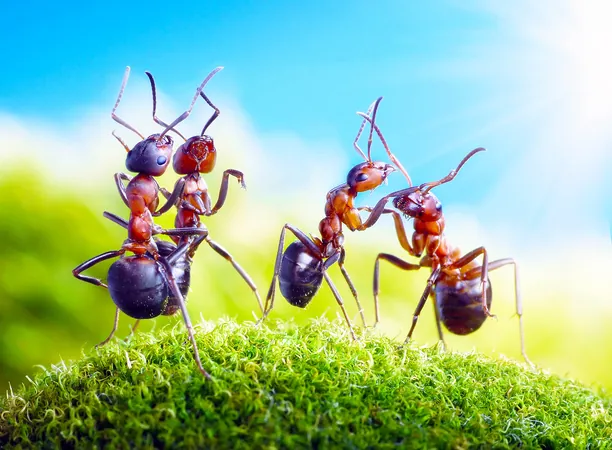
Discovering Earth's Ant Population: 20 Quadrillion and Counting!
2025-04-05
Author: Ken Lee
Questions about our planet's vastness often leave us astonished. How many stars shimmer in our night sky? How many grains of sand blanket the Sahara? And perhaps most intriguingly, how many ants scurry across the Earth at any moment?
With the advancement of research techniques and the rise of artificial intelligence, scientists have begun to answer these seemingly unanswerable queries. In an exciting exploration of the ant world, researchers from Germany's Julius-Maximilians-Universität Würzburg have uncovered mind-boggling numbers about these resilient insects.
Ants: Nature’s Social Butterflies
Estimates suggest that around 22,000 ant species inhabit our planet. Their success is largely attributed to their complex and efficient social structure, where different members focus on reproduction, caring for the young, nurturing the sick, and foraging for food.
Ants operate on the principle of collective intelligence—much like neurons in the human brain function collectively to create incredible outcomes. This cooperation is reflected in the intricate pathways they forge, their ability to create bridges from their bodies, and their fascinating behavior of farming fungi and aphids. In some scenarios, ant colonies outsmart humans in cooperative tasks!
Where Are All the Ants?
Ants flourish mainly in tropical and subtropical climates, often nesting among leafy forest floors or bustling across arid soils. Understanding their geographical preferences can provide crucial insights into how temperature and climate influence their populations.
Interestingly, while ants contribute significantly to maintaining healthy ecosystems—such as through nutrient recycling and forming beneficial partnerships with plants and other insects—not all interactions are friendly. Invasive species like fire ants can wreak havoc on native wildlife, leading to a decline in biodiversity.
The Impact of Ants on Ecosystems
Ants play a crucial role in our ecosystems. Their activity moves vast amounts of soil—up to 13 tons per hectare annually—facilitating nutrient cycling. Furthermore, their penchant for seeds helps spread plant species far and wide.
Researchers estimate that the global ant population is an astounding 20 quadrillion—yes, that’s 20 with 15 zeros! This mind-blowing number underscores their dominance, as the combined biomass of ants surpasses that of wild birds and mammals and accounts for approximately 20% of human biomass.
The Challenges of a Changing Climate
As our global climate changes, scientists are intrigued about how ant populations will adapt. Recent research highlights the critical need for a quantitative overview of ant populations, revealing numerous questions about how these creatures will respond to habitat changes and climate stressors.
Ants are often underestimated, seen merely as pests. However, their tunnels facilitate water absorption in the soil, and they serve as essential links in the food chain by being prey for various animals. Problems arise primarily when invasive species disrupt local ecosystems, potentially leading to cascading effects on biodiversity.
A Call for Further Research
Researchers are eager to refine their analysis of ant populations, focusing on how different species respond to climate extremes or habitat alterations over time. This painstaking work can provide vital data for farmers regarding pest management and highlight regions vulnerable to invasive ant species.
While ants are small, their influence on ecological processes is immense. Their abilities to transform environments and aid in resource distribution warrant comprehensive further study. Each ant species plays specific roles, emphasizing the need for conservation and balance within ecosystems.
Conclusion: The Unsung Heroes of Nature
Though often overlooked, ants warrant significant attention in discussions surrounding ecology and environmental health. They shape our surroundings, assist in seed dispersal, and are more numerous than most can fathom. Their intricate roles in sustaining ecosystems highlight the delicate balance of nature.
The landmark study titled "The abundance, biomass, and distribution of ants on Earth," published in the Proceedings of the National Academy of Sciences, is a call to recognize the profound impacts these tiny creatures have on the world—a reminder that even the smallest beings can drive large-scale ecological processes.
Join the conversation about the vital roles ants play and discover the unseen dynamics of the natural world!



 Brasil (PT)
Brasil (PT)
 Canada (EN)
Canada (EN)
 Chile (ES)
Chile (ES)
 Česko (CS)
Česko (CS)
 대한민국 (KO)
대한민국 (KO)
 España (ES)
España (ES)
 France (FR)
France (FR)
 Hong Kong (EN)
Hong Kong (EN)
 Italia (IT)
Italia (IT)
 日本 (JA)
日本 (JA)
 Magyarország (HU)
Magyarország (HU)
 Norge (NO)
Norge (NO)
 Polska (PL)
Polska (PL)
 Schweiz (DE)
Schweiz (DE)
 Singapore (EN)
Singapore (EN)
 Sverige (SV)
Sverige (SV)
 Suomi (FI)
Suomi (FI)
 Türkiye (TR)
Türkiye (TR)
 الإمارات العربية المتحدة (AR)
الإمارات العربية المتحدة (AR)